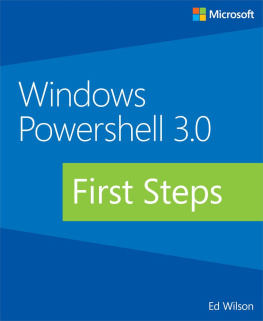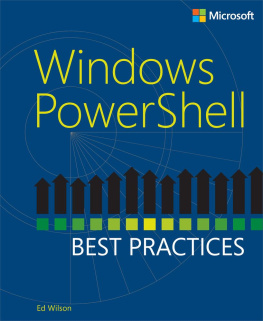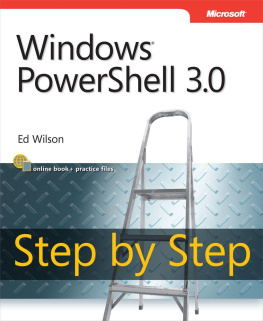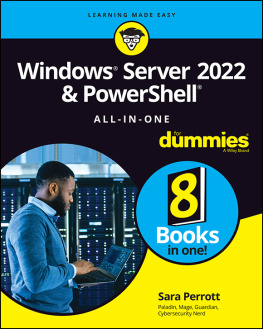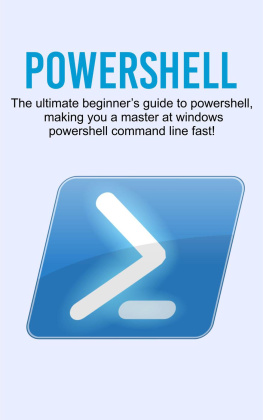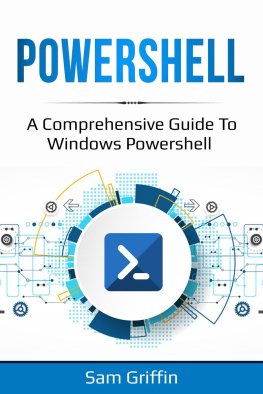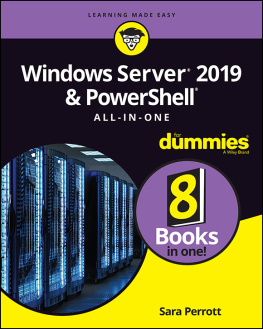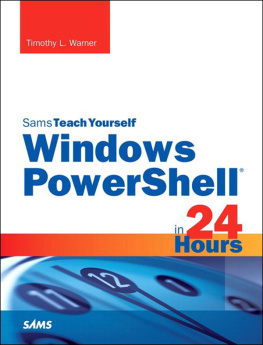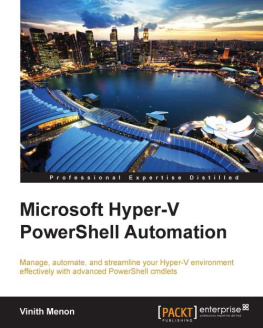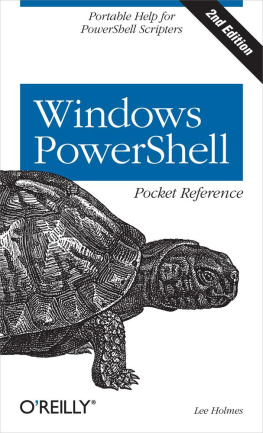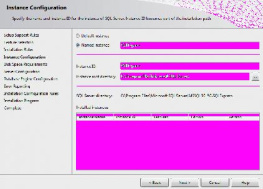Windows PowerShell 3.0 First Steps
Ed Wilson
Published by Microsoft Press
To Teresa, my soul mate .
E D W ILSON
Special Upgrade Offer
If you purchased this ebook directly from oreilly.com, you have the following benefits:
DRM-free ebooksuse your ebooks across devices without restrictions or limitations
Multiple formatsuse on your laptop, tablet, or phone
Lifetime access, with free updates
Dropbox syncingyour files, anywhere
If you purchased this ebook from another retailer, you can upgrade your ebook to take advantage of all these benefits for just $4.99. to access your ebook upgrade.
Please note that upgrade offers are not available from sample content.
Foreword
There are many reasons to get started with automation. For me it was a little turtle from a program called LOGO. Of course, at the time I had no idea I was learning programming. I was just a kid in elementary school having fun, drawing little pictures. Years later, I became an IT administrator and developed an aversion to tedious tasks, such as manually copying a file to 100 remote servers. I started automating because I just couldnt stand the thought of repeating monotonous tasks over and over again. It took a while before I connected the dots and realized that the little turtle had paved the way for a career focused on using and teaching automation.
Windows PowerShell has really hit a sweet spot with automation in the Windows universe, balancing powerful and far-reaching capabilities while remaining simple enough that someone without deep technical expertise can start taking advantage of it quickly. Though Windows PowerShell can be a simple automation environment, it has nuances that can make it a bit tricky to really master, akin to driving a car with a manual transmission. It might be tricky to get started, but once the car is moving in first gear, the rest comes pretty easily. Ed Wilson has done a wonderful job in this book getting you started in Windows PowerShell, providing simple, prescriptive guidance to get you into first gear quickly.
As a Senior Premier Field Engineer and a Windows PowerShell Technology Lead for Microsoft Services, I spend most of my days in front of Microsofts customers trying to teach them Windows PowerShell and hopefully getting them to love Windows PowerShell as much as I do. In every class I teach, I cant stress enough the return on investment (ROI) you get from learning Windows PowerShell. It never ceases to amaze me how once you grasp the core concepts of Windows PowerShell, you can apply them over and over again to get so much business value and personal satisfaction.
One point I try to make during every class I teach is that the words Windows PowerShell and scripting can most definitely be mutually exclusive. Technically speaking, Windows PowerShell one-liners are still scripts, but to me they strike a nice balance between the creation of solutions and the need for developer-oriented skills. One-liners are usually very task-oriented and logically simple, yet they can accomplish a staggering amount of automation. Those who are just getting started with Windows PowerShell will find that they can become great at Windows PowerShell without writing scripts. Throughout much of this book, Ed has focused on the concepts and simplicity of Windows PowerShell. He doesnt talk directly about scripting until late in the book. Ultimately, scripting and tool-making become parts of the advanced users skill set, but you can go a long way before that needs to happen.
No matter how diverse the skill set of my students, there is something for everyone in my classroom. Windows PowerShell has been created in such a way that it can be fun and effective for everyone from the IT novice to the expert developer. For example, the fact that it is fully object-based and sits on top of the .NET Framework is a detail that pure beginners might have no knowledge of. They can go about their Windows PowerShell days simply running commands, never really digging into the object model, but still implement valuable automation. The day they learn about objects, they can start to unlock so much more. The fact that Windows PowerShell can appeal to such diverse skills levels simultaneously is amazing to me.
When I really think about the value of Windows PowerShell and why someone new to it should dive right in, I think about the fundamental comparison of creation vs. operation. By over-simplifying the roles in IT, you can see a dividing line between developers and administrators. Developers are creating solutions, and administrators are managing the design, deployment, and operation of the systems used in the process. Windows PowerShell can bridge the dividing gap to link it all together. It also allows administrators to create automation solutions without needing a true developer. There are enough elements in the Windows PowerShell language that hide and simplify the true complexity that lurks under the surface, allowing IT pros to be more effective and valuable in the workplace. Learning Windows PowerShell is an incredibly powerful tool that will truly make you more valuable to your business and often make your life easier in the process.
Ed The Scripting Guy Wilson is what some people call a PowerShellebrity. Hes a superstar in the Windows PowerShell world, has extensive scripting experience, and is one of the most energetic and passionate people I have ever met. I am grateful that Ed writes these books because it allows so many people access to his extensive experience and knowledge. This book is such a concise and easy way to get started with Windows PowerShell, I cant imagine putting it down if I were a beginner. Whether you have already started your Windows PowerShell journey or are just getting started, this book will help define your next steps with Windows PowerShell.
Senior Premier Field Engineer (PFE)
Microsoft Corporation
Gary Siepsert
Introduction
Gary said nearly everything I wanted to include in the Introduction. I designed this book for the complete beginner, and you should therefore read the book from beginning to end. If you want a more reference oriented book, you should check out my PowerShell Best Practices books, or even PowerShell 3.0 Step by Step . Actually, the Step by Step book is not really a reference, but a hands-on learning guide. It is, ideally, the book you graduate to once you have completed this one. For your daily dose of PowerShell, you should check out my Hey Scripting Guy blog at www.ScriptingGuys.com/blog . I post new content there twice a day.
System Requirements
Hardware Requirements
Your computer should meet the following minimum hardware requirements:
Software Requirements
To complete the exercises in this book, you should have Windows PowerShell 3.0 installed:
You can obtain Windows PowerShell 3.0 from the Microsoft Download Center by downloading the Windows Management Framework and installing it on either Windows 7 Service Pack 1, Windows Server 2008 R2 SP1, or Windows Server 2008 Service Pack 2.
Windows PowerShell 3.0 is already installed on Windows 8 and on Windows Server 2012. You can obtain evaulation versions of those operating systems from TechNet:
http://technet.microsoft.com/en-US/evalcenter/hh699156.aspx?ocid=wc-tn-wctc
http://technet.microsoft.com/en-US/evalcenter/hh670538.aspx?wt.mc_id=TEC_108_1_4

